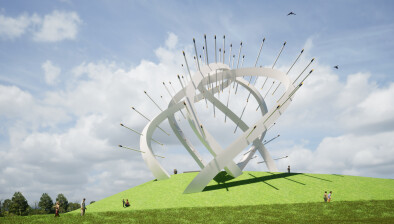And finally… Dundee V&A brought to life through interactive 3D visualisations
An exact digital 3D visualisation has brought the V&A museum in Dundee to life, years ahead of schedule.
The interactive, open-world virtual reality visualisation allows users to explore the museum as it will look when fully constructed in 2018.
Created by specialist 3D experience firm Live Visualisations, the virtual tour shows off the impressive building exactly as acclaimed Japanese architect Kengo Kuma designed it.
“It’s essentially a reality replication, or a virtual construction of the real thing. We literally use the architect plans to create a virtual version,” company founder Chris Bradwell told STV.
“Like the real construction we used the architect’s drawings to construct the digitally mirrored building, inside and out, for a smooth interactive and immersive 3D experience.”
“What’s going on here is far more ambitious than a fly through video,” continued Chris, 32, from Sheffield originally.
“Because it’s a game, built with 3D game technology, it’s actually an open world, a world where individuals can explore freely, in their own time, their own space or on their own virtual reality headset.”
“It could be used to increase exposure and boost interest in the museum, and to make the virtual replica available to the widest possible audience so people can experience the building as it will be, ahead of time.”
Over three years in the making, the visualisation runs on laptops, tablets and mobile phones and could become available as a downloadable app for smart phones – allowing users to navigate the museum with their fingers.
This means that it could potentially project the V&A around the world, allowing people who have never even been to Dundee to explore it from afar.
But, excitingly, it is also compatible with the latest virtual reality headsets made by Oculus Rift, a company bought in March this year by Facebook for $2billion - something Chris hopes will help to propel the visualisation around the world
“It runs on virtual reality headsets or on mobile devices, there are just different options for people to choose.” said Chris.
“So you could have people putting on the headset on the V&A’s touring bus or, by the time a year comes round, on their own consumer virtual headset.
“The virtual reality headset technology is good enough and cheap enough that it’s going to start being a desirable accessory - hence Facebook have bought Oculus Rift.
“There’s a movement around the globe and we’re searching to do other prolific projects like the V&A.”
Commissioned by the V&A to create the original fly through video, Live Visualisations went on to create the digital replica of the museum without being commissioned in the hopes of boosting interest in the real thing.
“It’s been made to be widely enjoyed but it’s still waiting to fulfil its purpose as there are no plans to release it publicly - but this could change if the public shows enough interest,” Chris said.
“Something designed well makes the technology invisible. When I visited the V&A in London there was an exhibited quote that said ‘the best use of technology is when it’s invisible’ and that’s kind of been my mantra developing the company.”
“I want the spotlight to be on the experiences not the technology so if the technology doesn’t get in the way of a great user experience, we’re all winning.”
Despite the picture below suggesting otherwise, the visualisation was designed to be as simple to use as possible, and Chris said he believed that it could one day be part of the museum itself, as a changing exhibition open to the public to experiment with.
“The V&A is an icon because it’s so unique and ambitious and that’s what I’m trying to do here,” added Chris.
“I wanted to make an interactive 3D experience which is memorable; a great way to engage the community with the building and its purpose, and to engage with each other.
“I want interactions to be a reason to experiment with the real building and digital building in tandem.”
Construction on the £80 million V&A Museum is expected to be completed by the end of 2017, and it could open by June 2018. More information on the V&A can be found online.

















